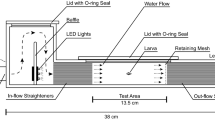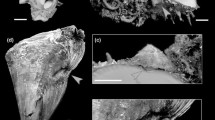Abstract
Determining the scale of larval dispersal and population connectivity in demersal fishes is a major challenge in marine ecology. Historically, considerations of larval dispersal have ignored the possible contributions of larval behaviour, but we show here that even young, small larvae have swimming, orientation and vertical positioning capabilities that can strongly influence dispersal outcomes. Using young (11–15 days), relatively poorly developed (8–10 mm), larvae of the pomacentrid damselfish, Amblyglyphidodon curacao (identified using mitochondrial DNA), we studied behaviour relevant to dispersal in the laboratory and sea on windward and leeward sides of Lizard Island, Great Barrier Reef. Behaviour varied little with size over the narrow size range examined. Critical speed was 27.5 ± 1.0 cm s−1 (30.9 BL s−1), and in situ speed was 13.6 ± 0.6 cm s−1. Fastest individuals were 44.6 and 25.0 cm s−1, for critical and in situ speeds, respectively. In situ speed was about 50% of critical speed and equalled mean current speed. Unfed larvae swam 172 ± 29 h at 8–10 cm s−1 (52.0 ± 8.6 km), and lost 25% wet weight over that time. Vertical distribution differed between locations: modal depth was 2.5–5.0 and 10.0–12.5 m at leeward and windward sites, respectively. Over 80% of 71 larvae observed in situ had directional swimming trajectories. Larvae avoided NW bearings, with an overall mean SE swimming direction, regardless of the direction to nearest settlement habitat. Larvae made smaller changes between sequential bearings of swimming direction when swimming SE than in other directions, making it more likely they would continue to swim SE. When swimming NW, 62% of turns were left (more than in other directions), which would quickly result in swimming direction changing away from NW. This demonstrates the larvae knew the direction in which they were swimming and provides insight into how they achieved SE swimming direction. Although the cues used for orientation are unclear, some possibilities seemingly can be eliminated. Thus, A. curacao larvae near Lizard Island, on average swam into the average current at a speed equivalent to it, could do this for many hours, and chose different depths in different locations. These behaviours will strongly influence dispersal, and are similar to behaviour of other settlement-stage pomacentrid larvae that are older and larger.










Similar content being viewed by others
References
Almany GR, Berumen ML, Thorrold SR, Planes S, Jones GP (2007) Local replenishment of coral reef fish populations in a marine reserve. Science 316:742–744
Batschelet E (1981) Circular statistics in biology. Academic, London
Bay LK, Buechler K, Gagliano M, Caley MJ (2006) Intraspecific variation in the pelagic larval duration of tropical reef fishes. J Fish Biol 68:1206–1214
Brett JR (1964) The respiratory metabolism and swimming performance of young sockeye salmon. J Fish Res Board Can 21:1183–1226
Choat JH, Doherty PJ, Kerrigan BA, Leis JM (1993) A comparison of towed nets, purse seine, and light-aggregation devices for sampling larvae and pelagic juveniles of coral reef fishes. Fish Bull 91:195–209
Clark DL, Leis JM, Hay AC, Trnski T (2005) Swimming ontogeny of larvae of four temperate marine fishes. Mar Ecol Prog Ser 292:287–300
Fisher R, Bellwood DR (2001) Effects of feeding on the sustained swimming abilities of late-stage larval Amphiprion melanopus. Coral Reefs 20:151–154
Fisher R, Bellwood DR (2002) The influence of swimming speed on sustained swimming performance of late-stage reef fish larvae. Mar Biol 140:801–807
Fisher R, Bellwood DR, Job SD (2000) Development of swimming abilities in reef fish larvae. Mar Ecol Prog Ser 202:163–173
Fisher R, Leis JM, Clark DL, Wilson SK (2005) Critical swimming speeds of late-stage coral reef fish larvae: variation within species, among species and between locations. Mar Biol 147:1201–1212
Frith CA, Leis JM, Goldman B (1986) Currents in the Lizard Island region of the Great Barrier Reef Lagoon and their relevance to potential movements of larvae. Coral Reefs 5:81–92
Gerlach G, Atema J, Kingsford MJ, Black KP, Miller-Sims V (2007) Smelling home can prevent dispersal of reef fish larvae. Proc Natl Acad Sci 104:858–863
Hoese DF, Bray DJ, Allen GR, Paxton JR (2006) Fishes. Zoological Catalogue of Australia (ABRS & CSIRO Publishing) 35:1–2178
Jones GP, Planes S, Thorrold SR (2005) Coral reef fish larvae settle close to home. Curr Biol 15:1314–1318
Kingsford MJ, Leis JM, Shanks A, Lindeman K, Morgan S, Pineda J (2002) Sensory environments, larval abilities and local self-recruitment. Bull Mar Sci 70:309–340
Kocher TD, Thomas WK, Meyer A, Edwards SV, Paabo S, Villablanca FX, Wilson AC (1989) Dynamics of mitochondrial DNA Evolution in animals: amplification and sequencing with conserved primers. Proc Natl Acad Sci USA 86:6196–6200
Kocher TD, White TJ (1989) Evolutionary analysis via PCR. In: Erlich H (ed) PCR technology: principles and applications for DNA amplification. Oxford University Press, New York, pp 137–147
Leis JM (1986) Vertical and horizontal distribution of fish larvae near coral reefs at Lizard Island, Great Barrier Reef. Mar Biol 90:505–516
Leis JM (2004) Vertical distribution behaviour and its spatial variation in late-stage larvae of coral-reef fishes during the day. Mar Freshw Behav Physiol 37(2):65–88
Leis JM (2006) Are larvae of demersal fishes plankton or nekton? Adv Mar Biol 51:59–141
Leis JM, Carson-Ewart BM (1997) Swimming speeds of the late larvae of some coral reef fishes. Mar Ecol Prog Ser 159:165–174
Leis JM, Carson-Ewart BM (1998) Complex behaviour by coral-reef fish larvae in open-water and near-reef pelagic environments. Environ Biol Fish 53:259–266
Leis JM, Carson-Ewart BM (2001) Behavioural differences in pelagic larvae of four species of coral-reef fishes between two environments: ocean and atoll lagoon. Coral Reefs 19:247–257
Leis JM, Carson-Ewart BM (2002) In situ settlement behaviour of damselfish larvae (Pisces: Pomacentridae). J Fish Biol 61:325–346
Leis JM, Carson-Ewart BM (2003) Orientation of pelagic larvae of coral-reef fishes in the ocean. Mar Ecol Prog Ser 252:239–253
Leis JM, Carson-Ewart BM (2004) The larvae of Indo-Pacific coastal fishes: a guide to identification. In: Fauna Malesiana Handbook 2, 2nd edn. Brill, Leiden
Leis JM, Clark DL (2005) Feeding greatly enhances endurance swimming of settlement-stage reef-fish larvae (Pomacentridae). Ichthyol Res 52:185–188
Leis JM, Fisher R (2006) Swimming speed of settlement-stage reef-fish larvae measured in the laboratory and in the field: a comparison of critical speed and in situ speed. In: Proceedings of the 10th international coral reef symposium, Okinawa, pp 438–445
Leis JM, Stobutzki IC (1999) Swimming performance of late pelagic larvae of coral-reef fishes: in situ and laboratory-based measurements. In: Seret B, Sire J-Y (eds) Proceedings of the 5th Indo-Pacific fish conference, Noumea, 1997. Societe Francaise d’Ichtyologie & Institut de Recherche pour le Developpment, Paris, pp 575–583
Leis JM, Carson-Ewart BM, Cato DH (2002) Sound detection in situ by the larvae of a coral-reef damselfish (Pomacentridae). Mar Ecol Prog Ser 232:259–268
Leis JM, Hay AC, Clark DA, Chen I-S, Shao K-T (2006a) Behavioral ontogeny in larvae and early juveniles of the giant trevally, Caranx ignobilis (Pisces: Carangidae). Fish Bull 104:401–414
Leis JM, Hay AC, Trnski T (2006b) In situ behavioural ontogeny in larvae of three temperate, marine fishes. Mar Biol 148:655–669
Leis JM, Sweatman HPA, Reader SE (1996) What the pelagic stages of coral reef fishes are doing out in blue water: daytime field observations of larval behaviour. Mar Freshw Res 47:401–411
Murphy BF, Leis JM, Kavanagh KD (2007) Larval development of the Ambon damselfish Pomacentrus amboinensis, with a summary of pomacentrid development. J Fish Biol. 71:569–584
Randall JE (2005) Reef and shore fishes of the south Pacific. University of Hawaii Press, Honolulu
Randall JE, Allen GR, Steene RC (1997) Fishes of the Great Barrier Reef and Coral Sea. Crawford House, Bathurst
Saghaimaroof MA, Soliman KM, Jorgensen RA, Allard RW (1984) Ribosomal DNA spacer length in barley: Mandelian Inheritance, chromosomal location and population dynamics. In: Proceedings of the national academy of sciences of the United States of America vol 81, pp 8014–8018
Simpson SD, Meekan M, Montgomery J, McCauley R, Jeffs A (2005) Homeward sound. Science 308:221
Stobutzki IC (1997) Energetic cost of sustained swimming in the late pelagic stages of reef fishes. Mar Ecol Prog Ser 152:249–259
Stobutzki IC (1998) Interspecific variation in sustained swimming ability of late pelagic stage reef fish from two families (Pomacentridae and Chaetodontidae). Coral Reefs 17:111–119
Stobutzki IC, Bellwood DR (1997) Sustained swimming abilities of the late pelagic stages of coral reef fishes. Mar Ecol Prog Ser 149:35–41
Swearer SE, Shima JS, Hellberg ME, Thorrold SR, Jones GP, Robertson DR, Morgan SG, Selkoe KA, Ruiz GM, Warner RR (2002) Evidence of self-recruitment in demersal marine populations. Bull Mar Sci 70:251–272
Swofford DL (1998) PAUP* Phylogenetic Analysis using Parsimony (* and other methods). Sinauer Associates, Sunderland
Tanaka Y, Mori T (1989) Reproductive behaviour, egg and larval development of the Staghorn Damsel, Amblyglyphidodon curacao (Bloch), in the aquarium. Bull Inst Oceanic Res Develop Tokai Univ 10:3–12
Tanaka Y, Nitta M (1997) Reproduction and rearing of the damselfish, Chrysiptera parasema, in the aquarium. Bull Inst Oceanic Res Develop, Tokai Univ 18:63–75
Tanaka Y, Yamada K (2001) Reproduction and rearing of the damselfish, Chrysiptera hemicyanea, in the aquarium. Bull Inst Oceanic Res Develop Tokai Univ 22:49–63
Tanaka Y, Yamada K, Hayakawa Y, Watanabe D (2004) Reproduction and rearing of the damselfish, Pomacentrus pavo, in the aquarium. Bull Inst Oceanic Res Develop Tokai Univ 25:1–12
Taylor MS, Hellberg ME (2003) Genetic evidence for local retention of pelagic larvae in a Caribbean reef fish. Science 299:107–109
Thompson JD, Gibson TJ, Plewniak F, Jeanmougin F, Higgins DG (1997) The CLUSTAL-X windows interface: flexible strategies for multiple sequence alignment aided by quality analysis tools. Nucleic Acid Res 25:4876–4882
Thresher RE, Colin PL, Bell LJ (1989) Planktonic duration, distribution and population structure of western and central Pacific damselfishes (Pomacentridae). Copeia 1989:420–434
Wellington GM, Victor BC (1989) Planktonic larval duration of one hundred species of Pacific and Atlantic damselfishes (Pomacentridae). Mar Biol 101:557–567
Wright KJ, Higgs DM, Belanger AJ, Leis JM (2005) Auditory and olfactory abilities of pre-settlement larvae and post-settlement juveniles of a coral reef damselfish (Pisces: Pomacentridae). Mar Biol 147:1425–1434
Zar JH (1996) Biostatistical analysis, 3rd edn. Prentice Hall, Upper Saddle River
Acknowledgments
It is a pleasure to acknowledge the skilful field assistance of Marcus Gregson, Amanda Hay, Klaus Heubert, and Tom Trnski. As always, the staff of the Lizard Island Research Station made our work possible, and our stay pleasant and productive. Ash Fowler and Tom Mullaney provided essential assistance with the otoliths, and Iain Suthers provided laboratory facilities. Suzanne Bullock inked Fig. 2, and she, Michelle Yerman and Greer Howarth provided editorial assistance. The research was supported by ARC grant DP0345876 to JML and by the Australian Museum. KJW was supported by an Australian Postgraduate Award from the University of New South Wales.
Author information
Authors and Affiliations
Corresponding author
Additional information
Communicated by S.D. Connell.
Rights and permissions
About this article
Cite this article
Leis, J.M., Wright, K.J. & Johnson, R.N. Behaviour that influences dispersal and connectivity in the small, young larvae of a reef fish. Mar Biol 153, 103–117 (2007). https://doi.org/10.1007/s00227-007-0794-x
Received:
Accepted:
Published:
Issue Date:
DOI: https://doi.org/10.1007/s00227-007-0794-x




